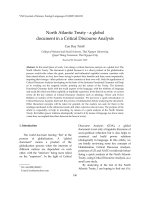The global digital economy a comparative policy analysis
Bạn đang xem bản rút gọn của tài liệu. Xem và tải ngay bản đầy đủ của tài liệu tại đây (2.1 MB, 302 trang )
The Global
Digital Economy
The Global
Digital Economy
A Comparative Policy Analysis
Carin Holroyd and Ken Coates
Copyright 2015 Cambria Press
All rights reserved
Printed in the United States of America
No part of this publication may be reproduced, stored in or introduced
into a retrieval system, or transmitted, in any form, or by any means
(electronic, mechanical, photocopying, recording, or otherwise),
without the prior permission of the publisher.
Requests for permission should be directed to:
, or mailed to:
Cambria Press
University Corporate Centre, 100 Corporate Parkway, Suite 128
Amherst, New York 14226, U.S.A.
This book has been registered with the Library of Congress.
Includes bibliographical references and index.
ISBN 978-1-60497-891-9 (alk. paper)
Table of Contents
List of Figures . . . . . . . . . . . . . . . . . . . . . . . . . . . . . . . . . . . . . . . . . . . . . . . . . . . . . . . . . . . . . . . vii
List of Tables . . . . . . . . . . . . . . . . . . . . . . . . . . . . . . . . . . . . . . . . . . . . . . . . . . . . . . . . . . . . . . . . . ix
Acknowledgements . . . . . . . . . . . . . . . . . . . . . . . . . . . . . . . . . . . . . . . . . . . . . . . . . . . . . . . . . . xi
Introduction: Government and the Realities of the New
Economy . . . . . . . . . . . . . . . . . . . . . . . . . . . . . . . . . . . . . . . . . . . . . . . . . . . . . . . . . . . . . . 1
Chapter 1: The Second Wave of the Digital Revolution . . . . . . . . . . . . . . . . 17
Chapter 2: The Contours of the Digital-Content Economy . . . . . . . . . . . . 63
Chapter 3: Government, National Innovation Strategies, and the
Emergence of the Digital-Content Sector . . . . . . . . . . . . . . . . . . 121
Chapter 4: Major Initiatives in the Content Revolution . . . . . . . . . . . . . . . 153
Chapter 5: Digital Futures . . . . . . . . . . . . . . . . . . . . . . . . . . . . . . . . . . . . . . . . . . . . . . . . 191
Chapter 6: Conclusion and Policy Recommendations . . . . . . . . . . . . . . . . . 219
Bibliography . . . . . . . . . . . . . . . . . . . . . . . . . . . . . . . . . . . . . . . . . . . . . . . . . . . . . . . . . . . . . . . . 241
Index . . . . . . . . . . . . . . . . . . . . . . . . . . . . . . . . . . . . . . . . . . . . . . . . . . . . . . . . . . . . . . . . . . . . . . . . . 277
List of Figures
Figure 1: Distribution of Internet users, 2000–2012 . . . . . . . . . . . . . . . . . . . . 47
Figure 2: Broadband prices versus speed, 2012 . . . . . . . . . . . . . . . . . . . . . . . . . 48
Figure 3: Internet users by language, 2011 . . . . . . . . . . . . . . . . . . . . . . . . . . . . . . 49
Figure 4: Internet users around the world . . . . . . . . . . . . . . . . . . . . . . . . . . . . . . . 49
Figure 5: Internet users by region . . . . . . . . . . . . . . . . . . . . . . . . . . . . . . . . . . . . . . . . 50
Figure 6: Mobile-phone subscriptions around the world, 2004–
2013 . . . . . . . . . . . . . . . . . . . . . . . . . . . . . . . . . . . . . . . . . . . . . . . . . . . . . . . . . . . . . . . . 50
Figure 7: Internet users around the world, 2004–2013 . . . . . . . . . . . . . . . . . 51
Figure 8: US device ownership over time . . . . . . . . . . . . . . . . . . . . . . . . . . . . . . . 52
Figure 9: Mobile share of noncomputer device traffic . . . . . . . . . . . . . . . . . 55
Figure 10: Noncomputer traffic share by devices . . . . . . . . . . . . . . . . . . . . . . . 57
Figure 11: App downloads and usage by country . . . . . . . . . . . . . . . . . . . . . . 58
Figure 12: Reasons for in-app purchases, 2011 . . . . . . . . . . . . . . . . . . . . . . . . 110
Figure 13: Mobile-game spending, 2011 . . . . . . . . . . . . . . . . . . . . . . . . . . . . . . . . 111
Figure 14: Countries’ wireless broadband subscriptions,
2013 . . . . . . . . . . . . . . . . . . . . . . . . . . . . . . . . . . . . . . . . . . . . . . . . . . . . . . . . . . . . . 144
viii
The Global Digital Economy
Figure 15: Percentage of fiber connections in total broadband
subscriptions, 2013 . . . . . . . . . . . . . . . . . . . . . . . . . . . . . . . . . . . . . . . . . . . . 147
List of Tables
Table 1: Mobile Internet services market, worldwide, 2009–
2015 . . . . . . . . . . . . . . . . . . . . . . . . . . . . . . . . . . . . . . . . . . . . . . . . . . . . . . . . . . . . . . . . . 51
Table 2: The top twenty-five: Leading Internet nations . . . . . . . . . . . . . . . . 53
Table 3: The bottom twenty-five: Lagging Internet nations . . . . . . . . . . . 54
Table 4: Countries with the highest rate of mobile share of web
traffic . . . . . . . . . . . . . . . . . . . . . . . . . . . . . . . . . . . . . . . . . . . . . . . . . . . . . . . . . . . . . . . 56
Table 5: Mobile share of web traffic worldwide . . . . . . . . . . . . . . . . . . . . . . . . 57
Table 6: Top ICT policies for the economic recovery . . . . . . . . . . . . . . . . . . 59
Table 7: The global games market, 2013 . . . . . . . . . . . . . . . . . . . . . . . . . . . . . . . . 107
Table 8: Market share for MMOGs . . . . . . . . . . . . . . . . . . . . . . . . . . . . . . . . . . . . . . 108
Table 9: In-app revenue by country . . . . . . . . . . . . . . . . . . . . . . . . . . . . . . . . . . . . . 109
Table 10: Features of “freemium” apps and their users . . . . . . . . . . . . . . . 109
Table 11: Features of mobile gaming, 2011 . . . . . . . . . . . . . . . . . . . . . . . . . . . . . 112
Table 12: Mobile movement . . . . . . . . . . . . . . . . . . . . . . . . . . . . . . . . . . . . . . . . . . . . . . 113
Table 13: Best-selling singles in Japan, 2013 . . . . . . . . . . . . . . . . . . . . . . . . . . . 114
Table 14: Top twenty iTunes singles in Taiwan . . . . . . . . . . . . . . . . . . . . . . . 115
x
The Global Digital Economy
Table 15: Best-selling singles in Germany, 2013 . . . . . . . . . . . . . . . . . . . . . . . 116
Table 16: Country rankings by number of fixed Internet
subscriptions, 2009–2013 . . . . . . . . . . . . . . . . . . . . . . . . . . . . . . . . . . . . . . 143
Table 17: Country rankings by percentage of fixed Internet
subscriptions . . . . . . . . . . . . . . . . . . . . . . . . . . . . . . . . . . . . . . . . . . . . . . . . . . . . 145
Table 18: Country rankings by mobile subscriptions . . . . . . . . . . . . . . . . . 146
Table 19: The Internet in Africa . . . . . . . . . . . . . . . . . . . . . . . . . . . . . . . . . . . . . . . . . 186
Table 20: Top ten Internet countries in Africa . . . . . . . . . . . . . . . . . . . . . . . . . 187
Acknowledgements
This book emerged out a longer term series of studies on national
innovation and the emergence of the new economy. We spent six years
at the University of Waterloo, in Waterloo, Canada, which has been one
of the most important North American hubs for the commercialization
of science and technology. We learned a great deal from our academic,
commercial, and government partners, particularly those associated with
the development of the University of Waterloo's Stratford campus.
Our work on this project was greatly assisted by our graduate assistants,
Jacob Hrycak and Natasha Kikot. Their cheerful attention to the details
of a very complicated research assignment was truly appreciated. We are
especially appreciative of the heroic efforts of Sherilee Diebold-Cooze,
whose editorial and technical assistance was a great help with the final
draft. We are thankful, as well, to our colleagues in the Faculty of Arts,
University of Waterloo, Department of Political Science, University of
Waterloo, Department of Political Studies, University of Saskatchewan,
and the Johnson-Shoyama Graduate School of Public Policy, University
of Saskatchewan. The research was made possible by grants from the
Social Science Research Council of Canada, the Canada Research Chairs
program, and the International Centre for Northern Governance and
xii
The Global Digital Economy
Development. Many thanks as well to the many people in various
countries––Scandinavia, across Europe, in Canada and the United States,
Brazil, Malaysia, Japan, Taiwan, China, Turkey, Hong Kong, New Zealand,
Vietnam, Qatar, among others––we interviewed in our attempts to learn
how government and industry are approaching the digital content sector.
Their willingness to share insights into national policies and program
innovations made this work possible. While we have acknowledged some
of their contributions in to the footnotes, we trust that they recognize
the important contributions that all of them made to the book. They are
not, of course, responsible for any errors remaining.
This is our second book with Toni Tan and her wonderful team at
Cambria Press. We particularly appreciate the efforts made by Toni Tan,
David Armstrong, and Michelle Wright to move the book to publication
in a timely fashion.
Family remains a source of inspiration. During the time that we
worked on this book, we welcomed three more grandchildren into the
fold, Christopher Coates, Victoria Griffin, and Hazel Coates, adding to
the joy that Katie Coates, Spencer Griffin and William Griffin were
already bringing to our lives. We were joined on some of our exploratory
expeditions by Les Holroyd, Carin’s father. His unexpected passing in
December 2013 was a shock and a great loss, of a father, a father-in-law,
and a true friend. Through 2011 to 2012, our daughter Hana, travelled with
us as we explored different manifestations of the global digital economy.
She inspired us, as well, by her creative (and unrelenting) engagement
with social media. It is truly amazing what one can learn from watching
a happy and digitally connected preteen! For her patience in travelling
far and wide in search of digital insights, we dedicate this book to Hana.
The Global
Digital Economy
Introduction
Government and the
Realities of the New Economy
Beginning with the dot-com meltdown in the late twentieth century,
then the rapid economic rise of China, and continuing through the
financial crisis of 2008–2009, the global economy has been in turmoil.
The most recent manifestations—staggeringly high levels of global youth
unemployment, the debt crisis in southern Europe, the scale of the United
States’ national debt, the continued erosion of traditional manufacturing—
illustrate the rapid transitions underway around the world. For national
and regional governments charged with maintaining jobs, creating and
sustaining prosperity, and financing needed social programs, responding
to the challenges of the twenty-first-century economy remains one of the
highest priorities. In the midst of this uncertainty, one economic sector—
information and communications technology (ICT), particularly digital
content (the preparation of value-added material for distribution via the
Internet or other digital means)—remains a significant bright spot in
terms of employment growth and business development. Governments,
however, have been slow to recognize the potential of digital content as
2
The Global Digital Economy
a commercial field and even slower to develop the policies and processes
necessary to capitalize on the emerging opportunities.
It is not that the world has ignored the potential of the digital-content
revolution. For over twenty years, public commentators have been
obsessed with the digital generation gap and the “digital divide” between
those with access to computers and the Internet and those without. As
personal computers became ubiquitous, particularly when smartphones
became the technology of choice for young people around the world,
global conversation focused on the idea of “growing up digital,” in Don
Tapscott’s words, and on the fundamental differences between members
of the predigital generation and their parents. The world embraced
the digital revolution, perhaps too enthusiastically and uncritically,
and certainly without much government attention or intervention. The
rapid and substantial commercial expansion based on the so-called new
economy focused initially on the dot-com boom, creating billions of
dollars in paper wealth. This was quickly followed by a dramatic stock
market crash that wiped out thousands of companies and hundreds of
thousands of overly enthusiastic investors.
The first stage of the digital transformation rested on the development
of the personal computer, symbolized by the global power of Bill Gates
and Microsoft and the cult-like reach of Steve Jobs and Apple Computer.
Beginning in the mid-1980s, the spread of personal computers altered the
way people did business, changed the entertainment industry through
the advent of CDs, DVDs, MP3 players, and video-game consoles, and
brought many unanticipated and dramatic changes. The second major
shift, tied to the development of the Internet and web browsers, allowed
for the near-instantaneous transmission of huge quantities of data across
great distances. The emergence of the Internet-based economy made
multimillionaires out of teenage computer wizards. “Geek culture” turned
the standard approach to wealth creation on its head, building a different
order that bore little resemblance to the long-standing industrial and
natural-resource economy.
Government and the Realities of the New Economy
3
For national and regional governments, the parameters of economic
planning and business forecasting had also changed rapidly. While the
industrial order underwent transitions of its own—particularly related to
the rise of China and India, rapid technological change, and the restructuring of work and business—the new economy presented governments
with formidable challenges. Even as dot-com millionaires became media
celebrities, lauded as much for their lifestyles as for their business acumen,
governments struggled to find policies and strategies that would cultivate and retain the companies, jobs, and wealth created by the digital
economy. Put simply, the digital revolution had changed economic rules,
undercutting elements of the old economy and creating unusual and
unpredictable models for the new order.
Mainframes soon gave way to desktop computers, which became
smaller, faster, and much more powerful. Computer memory expanded
dramatically, in accordance with Moore’s law, which anticipated that
memory capacity would double every eighteen to twenty-four months.
A seemingly endless array of new peripherals generated substantial
consumer interest. The advent of wireless Internet liberated digital users
from their computer desks, transferring speed and computing power to
handheld devices. Commercial innovations continued, most recently in
the form of tablet computers and progress in miniaturization, increased
computer power and faster Internet speeds. Businesses, even as they
pushed the technological frontiers, paid greater attention to pricing,
brand recognition, and aesthetics, the latter two underpinning Apple’s
rise to global digital dominance in mobile phones.
The computer revolution started in the industrial world, where
consumers could meet the initial high costs of entry into the sector (a
desktop computer followed by an expensive dial-up Internet connection)
and where large, prosperous populations in North America, northern
Europe, and Japan provided a foundation for the development of a global
industry. With each innovation, particularly those tied to smartphones
and wireless Internet, the reach of the digital revolution expanded. Speed
4
The Global Digital Economy
and capacity mattered, giving the leading nations a large advantage in
terms of connectivity and downloading abilities. That dramatic edge
started to decline in the early twenty-first century, again tied to the
spread of wireless Internet. Costs plunged, access and affordability spiked
upward, and consumers from rural China to Kenya, from the Pacific
Islands to South Asia came online via portable handheld devices. From a
rather limited launch in North America in the early 1990s, the Internet
spread faster than any technological advance in human history, becoming
a prominent foundation of the modern economy.
Scholars are now paying greater attention to the broadly transformative
potential of the digital revolution. There is a very large literature on the
business aspects of digital technologies, much of it hyperbolic and more
akin to commercial self-help books than to serious and sustained analysis
of the social and economic implications of digital content. This is now
changing. Works like Moises Naim’s The End of Power: From Boardrooms
to Battlefields and Churches to States; Why Being in Charge Isn’t What It
Used to Be explore the digital revolution’s implications for politics and
democracy, offering substantial and critical assessments of processes
like the Arab Spring uprisings in the Middle East and the long-term
effects of digital politics.1 Nicco Mele has made a similar point in The
End of Big: How the Internet Makes David the New Goliath, which offers
provocative commentary on the likely impact of digital technologies on
journalism, political organizations, recreation, government, the armed
forces, corporations, and postsecondary education.2 Perhaps the most
important of these studies is The Second Machine Age: Work, Progress,
and Prosperity in a Time of Brilliant Technologies, by Erik Brynjolfsson
and Andrew McAffee.3 In this highly original work, the authors have
moved beyond the standard business models to consider ways that this
new technological order—one based on digital communications—is likely
to disrupt the very foundations of contemporary society. Their study
drove them to three conclusions:
Government and the Realities of the New Economy
5
The first is that we’re living in a time of astonishing progress
with digital technologies—those that have computer hardware,
software and networks at their core.…
Our second conclusion is that the transformations brought about
by digital technology will be profoundly beneficial ones…
Our third conclusion is less optimistic: digitalization is going to
bring with it some thorny challenges.… Rapid and accelerating
digitization is likely to bring economic rather than environmental
disruption, stemming from the fact that as computers get more
powerful, companies have less need for some kinds of workers.
Technological progress is going to leave behind some people,
perhaps even a lot of people, as it races ahead.4
Futurists from Alvin Toffler on have written about the worrisome and
promising prospects of technological transformation for years. What
separates these works from previous commentaries is that they look more
systematically at the achievements, problems, and consequences of mass
digitalization on contemporary society. To summarize these three books
and the others that are starting to challenge normative assumptions
about technological change owing to digitalization, Brynjolfsson and
McAffee have asserted that governments should be profoundly attuned
to the disruptive capabilities of new technologies. They have also all
made the point that, to date, governments have been passive in the face
of digital transformations.
Beginning with the dot-com boom of the 1990s, politicians understood,
at the highest level, the economic importance of the new economy
and certainly appreciated the widespread enthusiasm for the latest
technologies. They soon learned to speak the language of the digital
revolution—with many famous fumbles, such as former Japanese prime
minister Yoshirō Mori’s laughable effort in the early 2000s to claim digital
chops before admitting he had never sent an e-mail message, American
vice president Al Gore’s alleged claims to have sparked the development
6
The Global Digital Economy
of the Internet, and a humorous 2013 contretemps involving Twitter, a
grammatical error by Aurelie Filippetti (the French minister of culture and
official guardian of the French language), and the response from French
linguistic purists along the way.5 Politicians spoke enthusiastically about
digital infrastructure, promised support for digital training programs,
and embraced digital entrepreneurs although they continued to favor
the hardware manufacturers and major service providers who looked
more familiar to them than animation studios and website designers did.
New terms—new economy, knowledge economy, digital natives, digital
innovation, and many others—flowed from their lips, demonstrating to the
electorate that political leaders and senior civil servants alike appreciated
the power and the potential of the digital revolution.
Time has shown that few national political leaders—Toomas Hendrik
Ilves, president of Estonia, standing as a key exception—truly understood
the transformative potential of the three key elements of the digital age:
computer technologies, Internet connectivity systems, and the design
and production of digital content. The production of digital devices
and the technological backbone of the Internet looked most familiar to
policy makers, who were comfortable with advanced manufacturing and
appreciated the opportunity to host or stimulate commercial development
in a field that seemed destined to replace a great deal of old-style
manufacturing. The Internet was not all that different, either, for it
replicated many of the same procedures and requirements of the earlier
development of radio and television. There was bandwidth to be regulated
and a wireless spectrum to be auctioned. Governments also had to
maintain traditional national efforts to control content delivery and
promote national culture through digital-content activities, and they used
national telecommunications regulators to manage Internet services. It
was content—from the largely invisible mobile-phone app producers
to the more prominent animation studios and website designers, ecommerce and e-government service providers, e-health initiatives, and
e-education content producers—that perplexed most governments.
Government and the Realities of the New Economy
7
Governments are not uniformly excited about the Internet and its
sociopolitical possibilities. China monitors Internet usage carefully and
has intervened with both individuals and companies to control content.
Dictatorships like Myanmar and theocracies like Iran are similarly
concerned about the libertarian nature of the Internet. In September 2014,
Russian president Vladimir Putin mused openly about the need for Russia
to assume control over the Internet, giving the country the capacity
to disengage in times of crisis and to regulate the flow of Western or
American content into the country.6 Though the idea was ridiculed by
other government leaders and analysts, that the president would speak
so openly about government concerns regarding global connectivity and
the free flow of ideas and services over the Internet highlights both its
strength and vulnerabilities.
The digital-content industry did not follow traditional industrial lines.
It looked more like the cultural sector, with its emphasis on creativity
rather than standard manufacturing. Even as some websites signed up
hundreds of millions of users, the size of the content companies in
terms of employees and physical presence was tiny compared to their
geographic reach and market valuation. Many of the entrepreneurs,
sporting more tattoos and piercings than typical industrial business
leaders, seemed out of step with normal government-business networks.
Compared to even the most competitive industrial and commercial
sectors, the digital economy seemed anarchistic. Indeed, many of the
most successful digital innovations, particularly those associated with
downloading music and the sharing of digital torrents (tiny portions of
movies, television programs, and music designed to reassemble at the
point of downloading) were clearly illegal. As entire sectors emerged
around digital sharing—and as regulatory and policing efforts targeted the
Internet sites facilitating the transactions and not at the end-point devices
(computers and the phones) that made downloading possible—it was not
surprising that most governments viewed the digital entrepreneurs with
a mix of suspicion, disbelief, and misunderstanding.
8
The Global Digital Economy
Digital media has emerged in recent decades as an economic force at a
time when governments have been struggling with national and regional
economic policy. The guarantees of the past have faded. Confidence has
declined in government economic leadership and state ownership, save
in China and in the energy sector. The public has also questioned the
ability of nation-states to insulate themselves from the vagaries of global
markets and transnational economic forces. The combined effects of the
financial crises of 2008–2009 that forced governments into emergency
measures to stabilize slumping economies left the global economic system
vulnerable and undercut the resilience of the European Union and the
United States, in particular. Even the major petro-states, long able to rely
on steady demand for oil and gas, have been challenged by the rapid
growth of shale gas development and by the consequent downward
pressure on oil prices and demand. With the world relying more heavily
on economic growth from the BRICSAM nations (Brazil, Russia, India,
China, South Africa, and Mexico), and with activity in these countries
waning in the past few years, political leaders are genuinely perplexed
about the best means of expanding and sustaining their economies.
In this complex and fluid global economic order, digital-content development represents one of the few areas ripe for continued expansion.
While traditional media companies—radio, television, movie production,
newspapers, and magazines—have suffered through competition with the
latest technologies, firms like Facebook, YouTube, China’s Alibaba, and
Japan’s Rakuten and Softbank have been experiencing significant, albeit
unpredictable, growth. As traditional industries from heavy manufacturing to retailing suffer from intense global competition, digital media
remains open, flexible, and creative. Digital firms regularly pop up in the
most unusual places, responding to local market conditions and consumer
needs and occasionally—like Skype, which was started in Estonia (by a
Dane, a Swede, and three Estonians) and is still substantially based there
—developing a global base within a few short years.
Government and the Realities of the New Economy
9
Governments have learned that digital connectivity—expanding and
promoting faster and cheaper Internet service—could quickly become an
electorate-pleasing staple with the potential to stimulate new digitally
based businesses. Nonetheless, governments have moved with widely
varying speeds in responding to the need for increased bandwidth, broader
coverage, and faster connections. The government of Japan, for example,
actively interfered with the early development of the Internet, which
was quickly bogged down in a morass of civic and national regulations,
before discovering the potential of the digital age immediately after the
1995 Kobe earthquake and moving quickly to put the country among the
world’s leading nations in terms of access, speed, and low cost. Canada,
conversely, was an early leader in widespread Internet connectivity, but
the promising start languished amid government regulation, the power of
the national telecommunications oligopoly, and the costs and complexities
of delivering high-quality, high-speed Internet services across the secondlargest country in the world. South Korea, at the opposite extreme from
Canada, emerged in the last decade as the most aggressive Internet
nation in the world, expanding fiber-optic connectivity and producing
some of the world’s fastest consumer Internet speeds and services at low
prices. Sub-Saharan African nations, without the government resources
to mount digital-media strategies of their own, have liberalized private
sector systems to permit companies to expand aggressively, particularly
in the wireless space.
Overall, governments responded surprisingly slowly to what was
obviously a promising opportunity. This did not hold for the entire digital
sector, however. National governments had been, from the late 1990s,
somewhat star-struck by the rise to prominence of California’s Silicon
Valley and sought to replicate its success. Silicon Valley emerged through
a unique combination of entrepreneurship (best represented by Hewlett
Packard), a world-class university (Stanford), military investments, and
access to large amounts of venture capital. The valley became synonymous with both the dot-com revolution and the dot-com crash. Later,
it reemerged with both hardware and software or digital-content firms.









